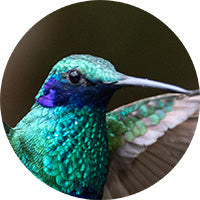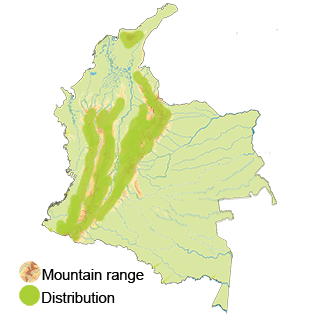Sparkling Violetear
The Sparkling Violetear (Colibri coruscans) is a striking species of hummingbird found in the Andean region.
Appearance: The Sparkling Violetear is characterized by its vibrant, iridescent green plumage on the upperparts, a brilliant violet-blue throat patch that gives it its name, and a white stripe behind its eyes. It has a long, slightly curved bill adapted for feeding on nectar from flowers. Adult males typically have more vivid colors and longer tail feathers compared to females.
Habitat: The Sparkling Violetear is primarily found in moist or wet mountain forests, montane grasslands, shrubby areas, and paramo ecosystems in the Andes mountains of South America, including Colombia. It is often seen in areas with abundant flowers for nectar feeding and may occur at elevations between 1,200 to 3,800 meters.
Behavior: These hummingbirds are known for their agility and fast wing beats, enabling them to hover in front of flowers while feeding. They are territorial and defend feeding territories or favored perches. Sparkling Violetears are vocal birds, known for their high-pitched calls and chirps.
Breeding: Breeding behavior typically occurs during the rainy season when there is an abundance of flowers and food. The female builds a cup-shaped nest made of plant fibers, cobwebs, and other materials in a sheltered location. A typical clutch consists of two eggs that are incubated for about 2 to 3 weeks before hatching.
Conservation Status: The Sparkling Violetear is considered relatively common in suitable habitat within its range, including areas like the Andes mountains. It benefits from the protection of national parks and reserves that preserve its highland habitat.
Distribution
The Sparkling Violetear hummingbird can be primarily found in the highland regions of the Colombian Andes. More specifically, this species is commonly seen in areas such as the Eastern Andes, Central Andes, and Western Andes of Colombia. These regions encompass a range of elevations and habitats typical of the Andean mountain range, including cloud forests, montane forests, and other high-altitude ecosystems.
Within these areas, you may encounter the Sparkling Violetear hummingbird in locations such as strategic forested areas, parks, gardens, and nature reserves that provide suitable conditions for this species to thrive.
Taxonomy
The Sparkling Violetear (Colibri coruscans)
- Kingdom: Animalia
- Phylum: Chordata
- Class: Aves (Birds)
- Order: Caprimulgiformes
- Family: Trochilidae
- Genus: Colibri
- Species: Colibri coruscans
Vocalization
Sparkling Violetear hummingbirds use vocalizations as a key form of communication within their social interactions and to convey various messages to other individuals in their habitat.
- Territorial Defense: Sparkling Violetears use vocalizations to establish and defend their territories. They may produce specific calls and trills to assert dominance and signal boundaries to other hummingbirds in the area.
- Courtship Displays: During courtship rituals, male Sparkling Violetear hummingbirds may perform elaborate flight displays accompanied by vocalizations to attract females. Their vocalizations play a role in mate attraction and pair bonding.
- Warning Signals: When faced with potential threats or intruders, Sparkling Violetears emit alarm calls to alert nearby individuals of danger. These vocalizations help in coordinating group responses to predators or other perceived risks.
- Feeding Communication: While feeding, Sparkling Violetears may use soft, subtle vocalizations to communicate with nearby conspecifics. These calls can help maintain social hierarchies at feeding sites and avoid confrontations over resources.
- General Communication: In everyday interactions, Sparkling Violetears use a variety of vocalizations to maintain contact with conspecifics, convey emotional states, and coordinate activities within their social groups.







